Catholic Customs
 |
 |
 |
 |
 |
 |
 |
The Christmas Crèche & Mystery Plays
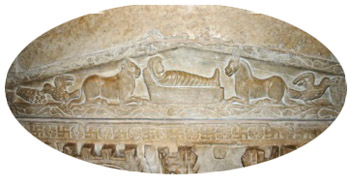
Nativity scene on a tomb in St. Sebastion Catacombs
Rome, the New Jerusalem, became the happy possessor of relics of the Crib when Pope Theodosius, himself a native of Jerusalem, arranged their transit in 636 to escape the Muslim invasion of the city.
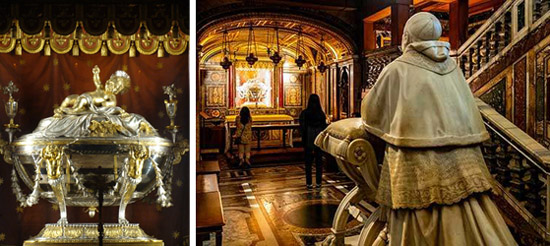
Pope Pius IX praying before the relics of the Holy Crib in Santa Maria Maggiore, Rome
Early Nativity scenes
The first Mass of Christmas Ad Praesepe was celebrated with special pomp by the Popes of the past in St. Mary Major. Pilgrims who traveled to Rome for this solemnity rejoiced to venerate the Crib and desired to experience something of this in their own churches. Soon, small Nativity scenes or cribs could be seen in many churches throughout Europe that eventually inspired unofficial liturgical dramas centered on the Crib.
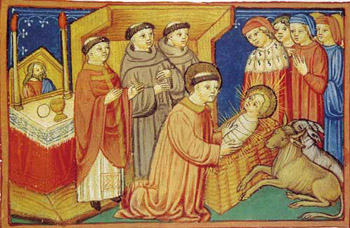
St. Francis’s first Nativity scene
This drama followed immediately after Matins and was performed by the choristers who chanted their lines recounting the Nativity story according to St. Luke.
The choristers donned costumes and appeared at their appointed times. In the first scene, a young boy, dressed like an angel, sang a chant announcing the Birth of Christ to the shepherds. Seven other singers joined the boy in intoning the Gloria in excelsis, and the shepherds approached the altar where two priests stood representing the midwives (popular characters in Medieval legends) beside the veiled Manger that cradled statues of Our Lady and the Christ Child.
The priests unveiled the Manger and introduced the kneeling shepherds to Our Lady with the words Ecce Virgo; the shepherds responded singing Salve, Virgo singularis. The touching drama ended with the choir singing Iam vere scimus. (3)
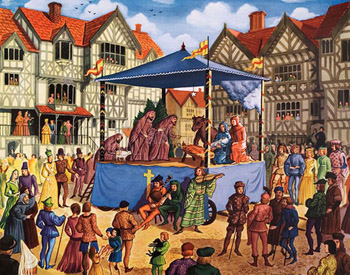
A medieval Mystery Play in a town square
The Seraphic St. Francis of Assisi was inspired to create a live Nativity scene that recaptured the original innocence of the first Christmas Night with even greater charm. In 1223 in the small village of Greccio, Italy, St. Francis acted as a deacon at the Midnight Mass said over the Manger of his live Nativity scene.
St. Francis’ first reenactment inspired the people to create, outside of the liturgy, marvelous mystery plays, pageants and Nativity scenes in palaces, town squares and peasant cottages throughout Christendom. Many towns and cities even began to sponsor annual Nativity plays that became elaborate productions. (4) Thus was the longing in the human soul for outward expressions of the mysteries so dear to Catholic hearts fulfilled.
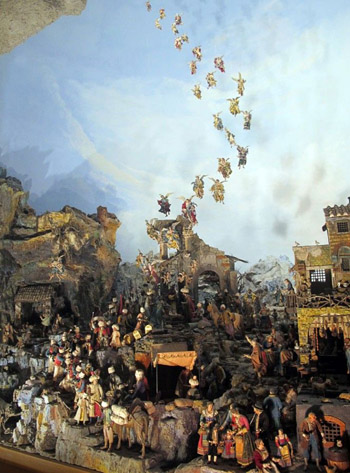
The Cuciniello Nativity in Naples, with the angels ascending from the Stable
In Provence on Christmas Eve, shepherds processed through the streets with their sheep, cattle, oxen, donkeys and horses singing carols and reenacting the Nativity story. The procession ended in the center of the town with a living crèche composed of the town's people. (5)
In small villages of the Tyrolese Alps up until the middle of the 20th century, the pious peasants gathered in large barns to watch dramatic retellings of the history of Redemption from the Creation of the World until the Birth of Our Lord. (6)
Nativity scenes
In the churches efforts were still made to represent the Nativity even without plays. The Franciscans, Capuchins and Bernadines used the Italian art of the marionettes to bring to life the Nativity scenes in their churches by including movable figures that could move about, bow down before the Christ Child, and perform other such movements by means of wheels and wires.
Unfortunately, as a sad result of the Revolution, by the 18th century abuses began to appear regularly in these locomotive scenes with the addition of profane characters and unseemly jokes that caused uproars amongst the onlookers. Thus, they were banned from the churches, but the beautiful Nativity scenes still remained in church and home. (7)
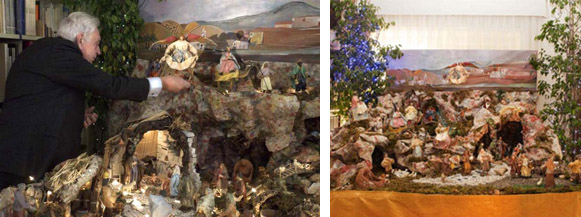
A Bavarian Paradeisl
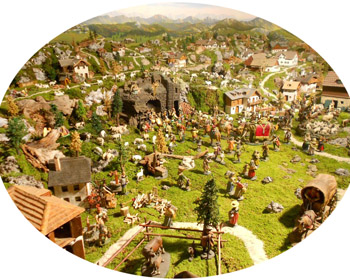
An Austrian creche from Ebenseer showing the countryside
A few days before Christmas, an expectant joy would permeate the woods and fields filled with gay throngs of children who cheered the air with songs as they collected bright berries, holly, laurel, lichens, stones and other greenery to adorn their Crèches.
Soon, a corner or mantle in every family home was transformed into a miniature landscape with hills, green meadows, powdery snow, rivers and any other features that inspired the creative home artisans. Flour supplied the snow, real water or blue silk created beautiful waterways. Flowers and fruit at times framed the scene as well.
After the landscape was complete, the land was filled with men and animal figurines, many being family heirlooms hand-carved and passed down through the generations.
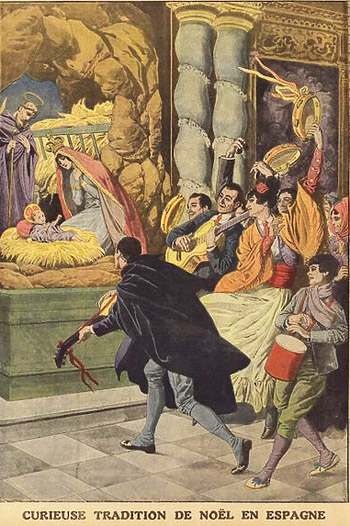
Spaniards dance & play instruments before the Crib
The final touch added to these scenes was light. Numerous candles were brought out for the occasion, but they remained unlit until Christmas Eve, when the true Light of the World would be placed into His Manger. As the sky darkened on Christmas Eve, everyone’s attention was directed towards the Crib as one chosen child solemnly carried the Christ Child and laid Him in His meager throne.
In Italy, the Christ Child was passed to every family member before He was laid in the Manger so that each person could offer a prayer to the Child Jesus. (9) In some Spanish speaking countries, a little boy called the “godfather” carried the statue of the Christ Child to the family Nativity scene and reverently placed it in the Crib after the father led the family in traditional prayers. (10)
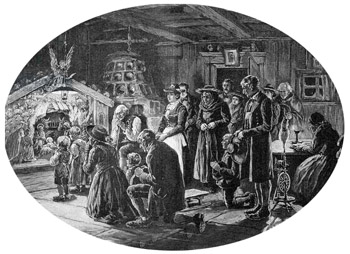
A Tyrolean family gathers to look at the Crib
The Nativity Scene was the center of all the Christmas festivity and the candles were lit every night from Christmas Eve until the Epiphany to add a special luster to the Christmas carols and stories that turned every night into a merry celebration.
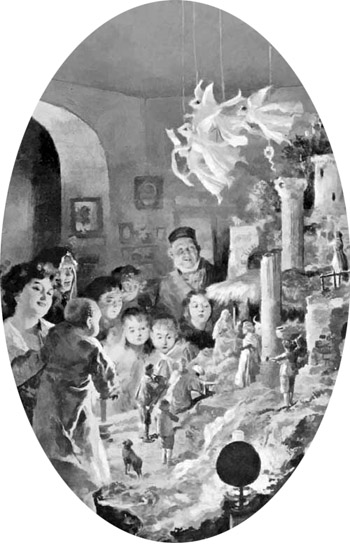
An Italian family admires their
elaborate home Creche
- Francis X. Weiser, The Christmas Book (New York: Harcourt, Brace and Company, 1952), p. 118.
- http://www.brauchtumsseiten.de/a-z/p/paradeisel/home.html
- Sophie Hodorowicz Knab, Polish Customs, Traditions, and Folklore (New York: Hippocrene Books, 1996), p. 31-32.
- https://www.arcanum.com/hu/online-kiadvanyok/MagyarNeprajz-magyar-neprajz-2/vii-nepszokas-nephit-nepi-vallasossag-A33C/szokasok-A355/jeles-napok-unnepi-szokasok-A596/december-A912/december-24-karacsony-vigiliaja-adam-eva-napja-A9B2/karacsonyfa-A9D3/
- Weiser, The Christmas Book, p. 119
- Maria Augusta Trapp, Around the Year with the Trapp Family (New York: Pantheon Books, 1955), pp. 52-56.
- Carol Field, Celebrating Italy (New York: William Morrow and Company, 1990), p. 255.
- Hodorowicz Knab, Polish Customs, Traditions, and Folklore, p. 31-33.
- Lee Wyndham, Holidays in Scandinavia (Champaign, Illinois: Garrard Publishing Company, 1975), p. 74.
- Weiser, The Christmas Book, pp. 127, 131.

Posted December 22, 2023
______________________
______________________
 |
 |
 |
 |
 |
 |


